The popularity of the Marigold flower probably derives partly from its ability to bloom brightly all summer. You will find many good reasons to plant Marigolds in garden beds, starting with their pleasant colors and easy growing methods. You can grow Marigold flowers from seeds easily. Marigold flowers are beautiful, providing your garden with numerous flowers in shades of yellow, orange, gold, and bronze. All the Marigolds are perfect for attracting pollinated insects. The leaves all are finely divided, which is strongly aromatic.

How to grow Marigold flowers from seed to harvest
How long do Marigolds take to grow from seed to flower?
- Plants that once flower and fall are called annual plants, as Marigold, Wheat, and Rice plants are annual plants that take three months to flower and survive for a year. Marigold seeds take about five to ten days to germinate and grow very quickly, taking about eight weeks to bloom.
- Marigolds grow annually in most areas. Where soil temperatures warm rapidly in spring and where spring temperatures are mild, Marigolds can be easily seeded into the ground at almost any point in the early to mid-spring. Early April is the best month to sow Marigold seeds. After planting seeds, the Marigolds take about 45 to 50 days to flower, so seeds sown in early April should flower in May.
Harvesting stage of Marigold
- The Marigold flowers will be ready for harvest in about 2.5 months from the date of transplantation. This plant continues to flower for another 2 to 2.5 months from the first harvest date. You should harvest flowers when they have attained full size. Cut the flowers in the evening and cut some of the stalks with them.
- The flowers are harvested in the evening, shortly before they fully bloom. You should irrigate the field before plucking so those flowers stay well long after harvesting. Regular picking improves production.
Is Marigold plant is cultivated in all season?
- You can grow Marigolds in almost all seasons except in very cold weather, as they are prone to frost. Marigolds require luxuriant growth and a much lighter climate of flowering.
- Annual Marigolds are frost-tender plants and will die from a late fall after the temperature drops below freezing. Cut back Marigolds to the ground with a clean shear, or pull them to the roots after they die completely.
- Marigolds grow well in full sunshine and can often withstand very hot summers. African and signet Marigolds tolerate drought conditions, while French Marigolds tolerate wet conditions. If you plant Marigolds in the shade and cold, moist areas, Marigolds are prone to powdery mildew and will not bloom well.
In case you missed it: How to Prepare the Soil for Marigold Plants: Best Soil Mix, pH, and Compost
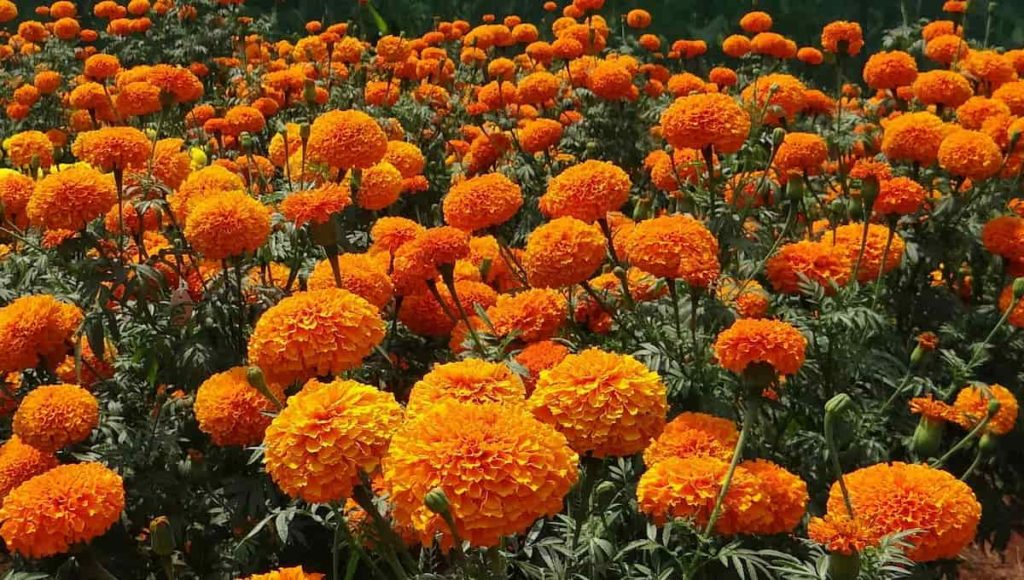
Marigold seeds harvesting and storing
- Harvesting and storing Marigold seeds is fast and easy. You should remove the seeds from the flowers when the petals are dry, and the base of each bloom is turning brown, and let them dry before storing them in winter.
- Saving Marigold seeds for the next season is a fairly simple process, requiring just a paper towel to dry the seeds, a paper envelope to store them, and a dark, cool place to store the seeds until you’re ready to plant them.
- After collecting seeds from Marigold flowers, keep them out for a day or more to dry. You can store the seed in a paper envelope to avoid any extra moisture. Plant them in the spring, and you will have a new generation of Marigolds.
- Once the seeds are completely dried, they can be scooped and stored away. Check them after a week, picks up a seed, and try to snap it in half. If it is dry enough, it should be broken. If it bends, let them dry further.
- The way to tell if the Marigold seed is still viable is by checking how dry it is. If the seed has been exposed to humidity or dampness, it is probably unsuitable for germination. If your seeds bend and break, they’re probably dry enough to plant.
Is Marigold easy to grow from seed?
You can grow Marigolds easily from seeds. If you’re sowing seeds indoors, you can start growing them any time between late winter and early spring, while if you’re planting them directly, wait until late spring to early summer before sowing your seeds. Marigolds are incredibly simple and reliable under a wide range of growing conditions. Once planted, the Marigolds grow rapidly without any fuss. Most thrive in the full sun, taking hot, sunny exposure.
Growing Marigold from seed
- You can easily grow Marigolds from seed, and they can provide a stunning splash of colors all summer. If you’re starting indoors, sow seeds in a well-drained, rich, soilless growing medium in a warm place. Scatter the seeds over the mix, then cover them with a very thin layer, less than 1/4 inch of the medium. Marigold seeds usually take five to seven days to germinate.
- Sow indoors 6 to 8 weeks before the last frost, or sow directly two weeks before the last frost. If starting indoors, cover the seeds with vermiculite and provide a soil temperature of 21°C to 25°C. Seeds should sprout in 4 to 14 days at this temperature. Marigolds are usually flowered from May-September. Marigold seeds will take 45 to 60 days to grow into flowering plants.
- You can plant young French and Signet Marigolds from spring to mid-summer, but tall African Marigolds are planted immediately in the spring (after the danger of frost has passed) because they are slow to mature and produce flowers.
Do Marigolds come back every year?
- Garden Marigolds are annual, meaning they grow, bear flowers, and die in a growing season. Usually, their maximum age is less than a year, even when they start indoors early in the year instead of starting with seeds directly in the garden.
- The most common types of Marigolds for gardening are annual. This means they sprout, flower, and die within the same year. However, the flowers return next year mainly because of their self-seed capacity.
In case you missed it: 20 Common Marigold Plant Problems: How to Fix Them, Solutions, and Treatment
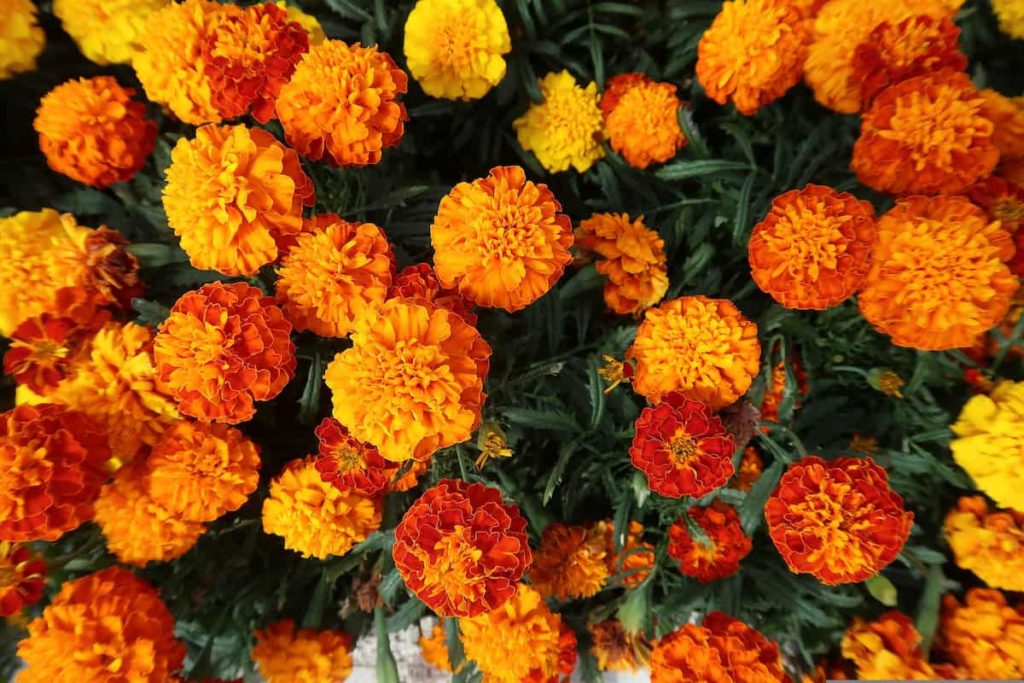
Can you start Marigold seeds indoors?
Indoors, you can start Marigold seeds, but they grow so easily outside that there’s no advantage. The exceptions are African Marigolds, best bought as young plants or started indoors about 4 to 6 weeks before your last frost date. When growing Marigolds indoors, you can enjoy their blooming throughout the year regardless of weather conditions. However, it will only thrive indoors near a proper sunglass window or with a supplement grow light.
How many Marigold seeds are in a hole?
- You should place groups of 3 or 4 seeds on the prepared soil, spaced at a distance of 6 to 12 inches, depending on the mature spread of your chosen type. If growing large varieties, you’ll need to leave more space between each plant.
- You should plant two to three seeds per hole. Seeds do not have a 100% growth rate, so not every seed planted will sprout. Moisten the soil, then sow the seeds at a distance of 6 inches and sow no deeper than 1 inch. Space French and Signet types at a distance of 8 to 10 inches. Large African Marigolds should be at least 10 to 12 inches apart.
Step-by-step Marigold seeds planting process
- Sow the seed directly into the ground and cover it with a thin layer of soil about 1/8 inch deep. Well-watered. The seedlings are thin at a distance of 8 to 18 inches after sprouting. You can also start Marigold plants indoors under grow lights and transplant them outdoors about six to eight weeks before the last frost date.
- French Marigolds can be easily started with seeds, while African Marigolds are purchased as young plants (when starting with seeds, they can take a long time to flower). If the soil is nutrient-deficiency, add some slow-release (granular) fertilizer to the planting hole. If transplanted, water each plant well after planting it in the garden.
Germinating Marigold seeds in a paper towel
- Spray the paper towel with hot water to moisten the towel evenly. Since many hybrid Marigolds do not produce seeds that will germinate successfully, it is better now than risking disappointment after planting their seeds.
- Place ten seeds at a distance of about an inch on a paper towel. Leave a 2-inch border between the edge of the seeds and the towel. Carefully fold the towel into a long 1- or 2-inch-wide strip. Put it in a sealable plastic food storage bag. You should set the bag in a warm room with a consistent temperature between 21°C to 25°C but out of direct sunlight. Check the paper towel daily for moisture. Don’t let it dry. Spray with hot water as needed to keep it evenly moist.
- After three days, carefully open the paper towel to see if a seed has shown signs of germination. Check again every day until most of the seeds have germinated.
In case you missed it: Growth Stages of Flowering Plants: Rose, Marigold, Hibiscus, Dahlia, Gerbera Daisy, and Jasmine
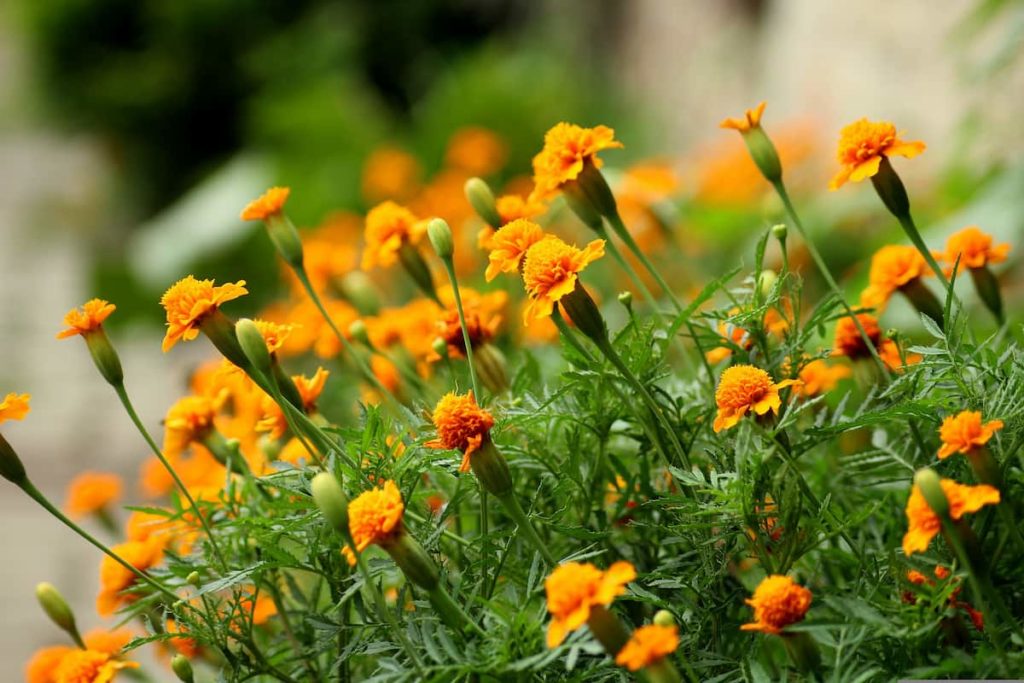
Sun requirement for growing Marigold
- Marigold seeds don’t need any light to germinate, so you don’t need to provide a light yet. The next step in germinating Marigolds from seeds is to test the seeds of Marigolds planted daily for germination. Usually, Marigold seeds take three to four days to germinate, but if the place is cold, it may take a few days longer.
- Too much sun and hot weather can dry out Marigold leaves, blooms, and stems, damaging the plant. The risk of Marigolds getting too much sun in cold areas is very low. If you’re growing Marigolds in a very hot summer region, a light afternoon shade can help protect your plant.
- Most Marigolds thrive in hot, dry conditions, but Marigolds can be successfully grown anywhere outside as long as the temperature remains above 5°C.
- Most varieties require at least 6 hours of sunlight daily to have a strong green color and vibrant flowers. If the plant stops blooming or the leaves of the plants become dull means your plant isn’t getting as much sunshine as it should is
Growing Marigolds in pots
- You should plant one Marigold in a 6-inch pot, but you can grow two or three in a 12-inch pot and five or more small plants in a large container with a diameter of 18 inches. Make sure the container has drainage holes.
- Any Marigold can be grown in containers, but keep in mind that some varieties, such as African Marigolds, can reach heights of up to 3 feet and be too large for standard containers. Most gardeners prefer to plant Marigolds grown in small containers.
- Marigolds require full sun and reasonably fertile, well-drained soil. Small Marigolds form good edge plants for borders and perform well in pots, while long or large flowering Marigolds can be grown in large pots or borders.
Water requirement for growing Marigold
- Marigolds require moist soil for the first or two weeks after planting to establish a strong root system. Once established, they need to be watered once a week and in summer when temperatures are high. Marigolds don’t need too much water. Give the soil where the Marigolds are planted give a good soak weekly.
- You should dry the soil in which the Marigolds are planted between the water if the Marigold is watered daily. Keep the soil slowly moist by watering an inch deep twice weekly from late spring to early autumn. If in a pot, check the flowers daily and water if the top half-inch of soil is dry.
- You should allow drying of the soil before watering again. Never allow the soil to remain soggy, as wet conditions invite root rot and other moisture-related diseases.
- If, for some reason, you prefer to water your Marigolds daily, make sure you water them very lightly. Ensure that the total amount of water does not exceed 1.5 to 3 inches per week. However, it is better to water the Marigold 1 to 2 times per week.
Pinching of Marigolds plants
- Use your thumb and finger to pinch the upper growing tip of the plant. Deadheading is removing dying flowers. This forces the plant to keep blooming instead of focusing on seed production.
- You can use pruners or pinch the heads of faded flowers. Be sure to cut flower pods that have also started to develop behind the flower. Your Marigold Garden may look perfect today, but then you’ll see faded flowers tomorrow. Continue removing dead and wilted flowers as they appear.
- While trimming your Marigolds, it’s essential to wait until they’re 6 to 8 inches tall but haven’t started making flower buds yet. Pinch the stem about 1/4 of an inch below the second set of leaves. Due to this pinch, the Marigolds will become branches at the pinch point, resulting in more flower buds.
- Once the Marigolds have established themselves, pinch the tops of the plants to encourage them to grow bushy. This will prevent the plants from getting taller and encourage more blooms.
In case you missed it: Marigold Gardening For Beginners – Planting FAQs
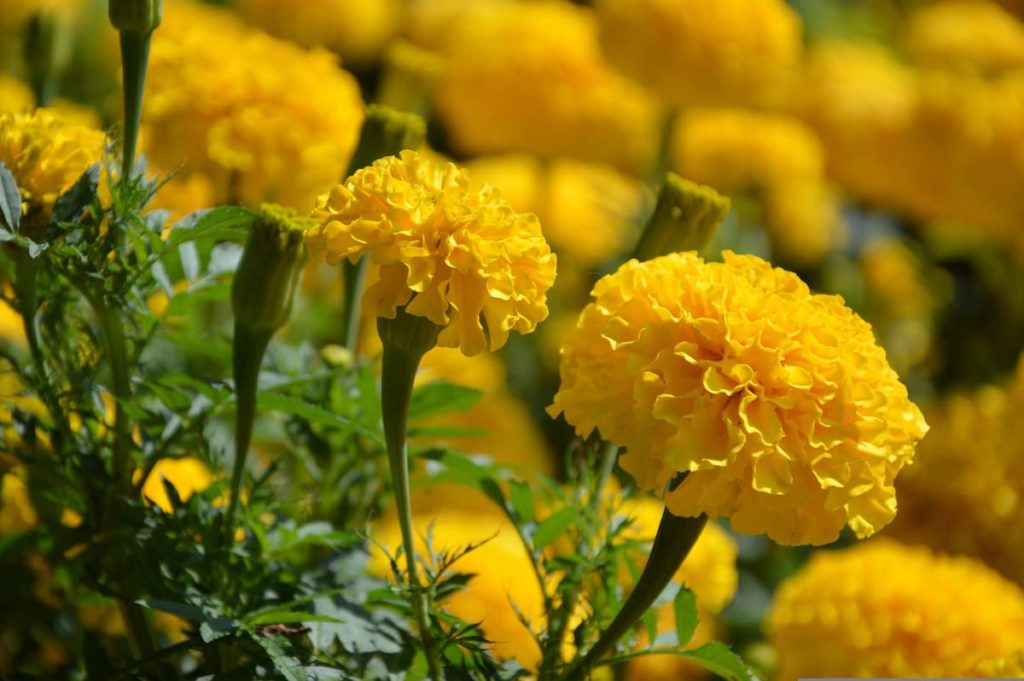
What pests do Marigolds keep away?
- Marigold is one of the most well-known insect repellents, and the proper reason for this is that they have a fragrance that will keep mosquitoes, cabbage worms such as nematodes, and other insects away. Marigolds attract beneficial insects that attack and kill aphids.
- French Marigolds have proved to be most effective when it comes to using Marigolds to control pests. Plow the Marigold into the soil at the end of the growing season to provide more control over the nematodes.
Why is my Marigolds not flowering?
- Marigold does not flower when they cannot get enough sunlight. They are pleased with the sunshine of the day, from morning to evening. Don’t hurt them to keep them shady anywhere. While not a bit will hurt, anything less than six hours of sunshine and you probably won’t see flowers.
- Marigolds grow faster, sprout within a few days, and bloom in about eight weeks, making it easier for them to grow from seeds. Marigolds and other flowering plants will reduce the number of flowers they produce, or if they do not get enough water, the flowers will stop producing completely. The plant is trying to conserve energy and moisture as it faces drought stress. In most cases, Marigold needs to be watered once every seven days.
Soil requirement for growing Marigold
- Marigolds grow best in a well-drained, loamy soil. Prepare flower beds by adding organic matter and cultivating the soil up to a depth of 6 inches. Modify the soil before planting according to the results of the soil test for the best results. An ideal soil for Marigold cultivation is fertile and sandy loam.
- They tolerate different soil types and also allow fluctuations in soil pH. The best conditions required for growing Marigolds include full sun and deep, fertile soils rich in organic matter. For growing Marigolds, you should have a soil pH of 6.0 to 7.5. In some cases, the Marigolds will grow in slightly more acidic soils, with a pH of less than 5.8.
How do you keep Marigolds blooming?
Marigolds don’t require deadheading, but if the dying flowers are removed regularly, it will encourage the plant to keep blooming a lot. When you water the Marigold, let the soil dry somewhat between the water, then water well and repeat the process. More water in intense heat. Do not water the Marigold from the top.
Fertilizer requirement for growing Marigold
- For best results, fertilize your Marigold every 10 to 14 days with a quarter to half of the usual recommended dose of your favorite flower fertilizer. This will allow plants to maintain a steady but manageable supply of nutrients to help power flowers to bloom continuously.
- Marigolds don’t need a lot of nutrients to thrive, but the proper application of a common-purpose fertilizer with equal amounts of nitrogen and potassium in the planting hole gives the young plant a healthy boost to start.
- As a general rule, Marigolds do not need fertilizer. If your soil is extremely poor or the growth appears weak, fertilize the plants every six weeks with dry, 5-10-5 fertilizer. Fertilize at the rate of 1 teaspoon per 1 square foot or 900 grams per 100 square feet of planting space.
In case you missed it: Growing Marigolds in Pots from Seed, Cuttings, Layering
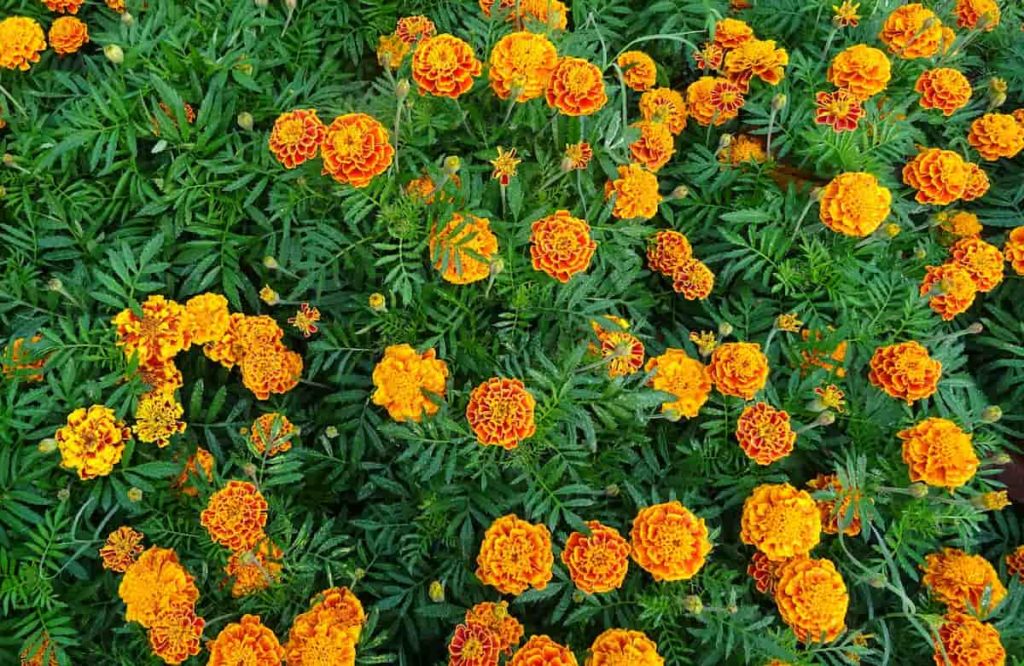
Why didn’t my Marigold seeds germinate?
The most likely reason for the seeds not germinating is too much or too little water. With little or no water, the seeds remain dormant. With too much water, seeds become susceptible to rotting or infection from soil-borne fungi. Marigold seeds do not need light to grow. If seeds are on top of the soil, then they are not covered, and they should be covered with a fraction of an inch (maybe 1/4 inch) of the potting medium (or soil, if planted directly outside).
How many times does Marigold bloom?
- Marigolds bloom once every year. The stem of each Marigold will usually produce one flower each year. Deadhead Marigolds can stimulate the plant to produce more flowers. Save the dry Marigold that you remove. Marigold plants will continue to grow without this part of care, and they will still bloom and continue to flower until the first frost.
- The production of flowers depends on the planting season and the cultural practices adopted. You can grow 4000 to 5000 plants on an acre, and one healthy plant will yield about 2 to 2.5 kg of flowers.
Why do my Marigolds keep dying?
- Your Marigold plant can wilt with too much water or too little water. Remember that Marigold plants that are wilting don’t necessarily need water. Sometimes Marigold plants wilt when there is too much water. Always check the dryness of the soil to determine if you should give some water to the Marigold plant.
Conclusion
Marigolds are one of the easiest flowers to grow from seeds. Marigolds prepare any garden with dark green ferny leaves, and the frilly composite blooms in a blast of yellow, orange, red, and bronze and a few two colors. Depending on the variety, they range from 6 inches to 6 feet long. An easy-to-grow plant, they thrive in sunny spots with loose, moist, well-drained soil. Don’t throw Deadheaded flowers if you have Marigolds growing in a container or your garden. Collect the seeds and replant them.
- Growing Gold: Essential Techniques for Planting Pineapples
- How to Make Kalanchoe Plant Bushy: Home Remedies and Solutions
- 11 Reasons Why Your Gardenia is Not Blooming: Home Remedies and Solutions
- Eco Elegance: The Guide to Designing a Drought-Tolerant Landscape
- Gardening on a Slope: Strategies for Hillside Landscaping
- Nourish and Flourish: Top Organic Mulches for Thriving House Plants
- Everything You Want to Know about Indian Mogra Flower: Discover Uses and Growing
- Green Thumb Success: Expert Tips for Cultivating Greenhouse Pumpkins All Year Round
- Maximize Growth & Flavor: The Ultimate Guide to Companion Planting in Herb Gardens
- How to Control Rhododendron Problems Naturally: Home Remedies and Organic Ways to Fix Them
- Natural Magic: The Remarkable Benefits of Cinnamon for Plants
- Best Steps to Revive Dying Tulip with Natural and Organic Treatment
- 10 Reasons Why Your Angel Trumpet is Not Blooming: Remedies and Treatment
- How to Fix Periwinkle Leaf and Flower-Related Problems: Natural Remedies and Solutions
- How to Fix Zinnias Leaf and Flower Problems: Discover Natural and Home Remedies
- Organic Steps to Induce Lemon Tree Flowers: A Comprehensive Guide
- Bloom Booster: Crafting the Perfect Homemade Bougainvillea Fertilizer
- Optimizing Growth: A Guide to Applying NPK Fertilizer for Potted Plants
- 10 Best Homemade Fertilizers for Rubber Plant: DIY Recipes and Application Method
- How to Boost Female Pumpkin Flowers: Effective Steps for More Flowers and High Yields
- Transform Your Indoor Garden: Top Benefits of Pink Salt for Houseplants
- 10 Best Homemade Fertilizers for Peacock Plants (Calathea): Easy DIY Guide
- Unlock Blooms: 9 Reasons Why Your Potted Chrysanthemum is Not Blooming
- 8 Reasons Why Your Potted Hibiscus is Not Blooming: Fix it with Simple Solutions
- Unlock Blooms: 9 Key Reasons Your Potted Frangipani Won’t Flower
- 10 Reasons Why Is My Ice Plant Not Blooming: Remedies and Treatment
- 10 Reasons Why My Potted Hydrangea Not Blooming: Treatment and Remedies
- 10 Reasons Why is My Wisteria Not Blooming: Remedies and Treatment
- 10 Reasons Why is My Goldfish Plant Not Blooming: Remedies and Treatment
- Maximize Your Space: Ultimate Guide to Balcony Gardening with Grow Bags
- 10 Reasons Why Your Iris is Not Blooming: Remedies and Treatment
- 10 Reasons Why Your Anthurium Plant is Not Blooming: Treatment and Remedies
- 10 Reasons Why Your Aquaponic Plants Are Not Flowering: Remedies and Treatment
- 10 Reasons Why Your Agapanthus is Not Flowering: Remedies and Treatment
- Ultimate Guide to Brown Turkey Fig: Steps to Growing Brown Turkey Figs
- How to Grow Acai Berry: Propagation, Planting, and Care